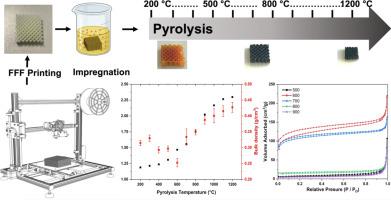Structural and microstructural evolution of fused filament fabricated SiOC(N) via polymer-derived ceramics route
IF 2.8
Q1 MATERIALS SCIENCE, CERAMICS
引用次数: 0
Abstract
Cellular SiOC(N) ceramics were produced by impregnating a 3D-printed TPU lattice with polysilazane, followed by pyrolysis in an inert atmosphere. During pyrolysis, TPU decomposes while polysilazane converts to ceramic. The process was analyzed across the full temperature range via weight loss, shrinkage, density, porosity, specific surface area, FTIR and Vickers hardness.
TPU decomposes between 380 and 550 °C with significant weight loss, while ceramization of polysilazane occurs between 550 and 800 °C, forming SiOC(N). Transient micro- and mesoporosity develops only at 600–700 °C. Skeletal density and hardness increase steadily up to 1200 °C.

聚合物衍生陶瓷熔丝制备SiOC(N)的结构与微观结构演变
通过在3d打印的TPU晶格中浸渍聚硅氮烷,然后在惰性气氛中热解,制备了多孔SiOC(N)陶瓷。在热解过程中,TPU分解,聚硅氮烷转化为陶瓷。在整个温度范围内,通过失重、收缩率、密度、孔隙率、比表面积、红外光谱和维氏硬度对该过程进行了分析。TPU在380 ~ 550℃之间分解,重量损失显著,而聚硅氮烷在550 ~ 800℃之间发生陶化,形成SiOC(N)。瞬态微孔和介孔仅在600-700°C时发生。骨骼密度和硬度稳定增加到1200°C。
本文章由计算机程序翻译,如有差异,请以英文原文为准。
求助全文
约1分钟内获得全文
求助全文
来源期刊

Open Ceramics
Materials Science-Materials Chemistry
CiteScore
4.20
自引率
0.00%
发文量
102
审稿时长
67 days
 求助内容:
求助内容: 应助结果提醒方式:
应助结果提醒方式:


